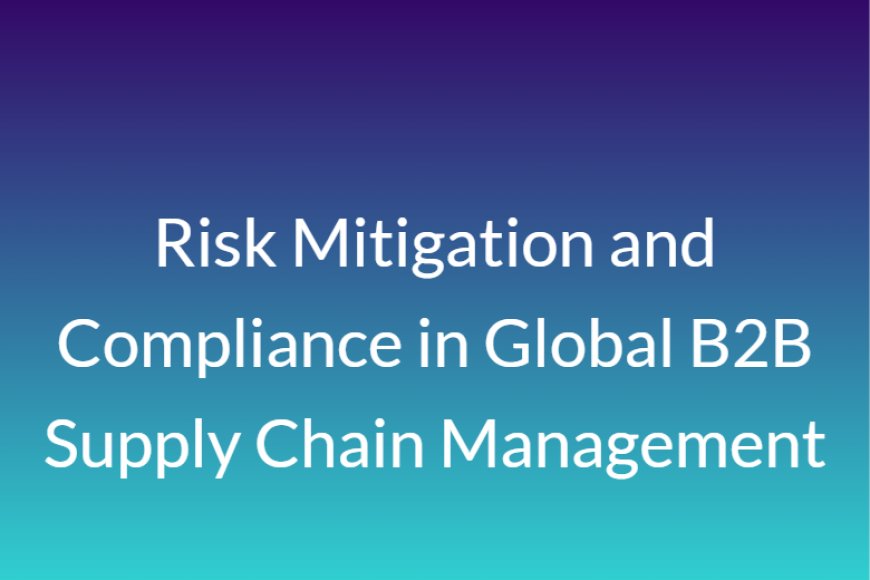Risk Mitigation and Compliance in Global B2B Supply Chain Management
Why Risk Is Inherent in B2B Supply Chain Management

In a globally connected marketplace, managing risk is no longer optional it's a strategic imperative. Disruptions like pandemics, geopolitical instability, cyberattacks, and climate-related disasters have made it clear that traditional supply chain models are vulnerable.
EffectiveB2B Supply Chain Management
must integrate proactive risk-mitigation strategies that anticipate threats and minimize their impact. Building resiliency into the supply chain is just as important as optimizing cost or efficiency.
Identifying Supply Chain Risk Categories
To manage supply chain risk, businesses must first classify potential threats. These typically fall into five categories:
-
Operational Risks Machinery breakdowns, labor shortages, production delays
-
Financial Risks Currency fluctuations, vendor insolvency, cost surges
-
Compliance Risks Regulatory changes, export/import violations, labor law breaches
-
Geopolitical Risks Tariffs, sanctions, political unrest
-
Environmental Risks Natural disasters, pandemics, climate events
Modern B2B Supply Chain Management strategies involve using this classification to assign likelihood, severity, and mitigation plans for each risk type.
The Role of Scenario Planning and Simulation
Scenario planning allows businesses to assess the impact of worst-case events and prepare mitigation paths. By modeling various situations such as port closures, demand spikes, or supplier failure organizations can develop response protocols.
Supply chain simulation tools enable companies to forecast the ripple effects of these disruptions. When embedded into B2B Supply Chain Management, scenario planning allows for faster decision-making under pressure and ensures a predefined plan is ready to be activated.
Multi-Sourcing and Geographic Diversification
Relying on a single supplier or manufacturing region can expose businesses to significant risk. Multi-sourcing involves diversifying your vendor base to ensure supply continuity even when one source is disrupted.
Geographic diversification is another layer of protection. Instead of sourcing only from one country, organizations build supplier networks across multiple regions to spread risk. In modern B2B Supply Chain Management, this practice ensures agility during trade wars, embargoes, or natural disasters.
Real-Time Risk Monitoring and Alerts
Real-time monitoring systems give supply chain managers immediate alerts when a disruption occurs. Whether its a border closure, factory strike, or regulatory change, early awareness is key to minimizing damage.
Effective B2B Supply Chain Management integrates these systems through supply chain visibility platforms, which track shipments, weather conditions, political events, and vendor communications. With real-time alerts, managers can reroute shipments, switch vendors, or notify customers before delays escalate.
Cybersecurity and Digital Supply Chain Threats
With supply chains increasingly digital, cyberattacks have become a serious risk. Data breaches, ransomware, and system intrusions can paralyze logistics and expose sensitive information.
A strong B2B Supply Chain Management approach includes cybersecurity protocols such as:
-
Secure APIs and system integrations
-
Network segmentation and firewalls
-
Regular vulnerability scans
-
Employee cybersecurity training
-
Third-party IT audits for vendors
A supply chain is only as strong as its weakest digital link. Ensuring vendor compliance with cybersecurity standards is crucial.
Regulatory Compliance Across Borders
Each country has its own regulations for trade, tax, labor, and environmental standards. Non-compliance can result in delays, fines, and reputational damage. As supply chains go global, tracking compliance across jurisdictions becomes complex.
B2B Supply Chain Management must include compliance audits, legal tracking systems, and partnerships with customs brokers and legal experts. Whether its REACH in Europe, USMCA in North America, or import quotas in Asia, understanding local compliance laws is essential to seamless operations.
Leveraging Compliance Management Software
Compliance management tools help streamline documentation, manage audits, and ensure your company meets the regulatory requirements of every market. These systems track certifications, vendor approvals, and expiration timelines for regulatory standards.
Incorporating these tools into B2B Supply Chain Management reduces administrative overhead, improves audit readiness, and helps avoid costly penalties. Automated alerts can notify managers when certifications are due for renewal or when a supplier falls out of compliance.
Third-Party Risk and Vendor Vetting
One of the largest sources of supply chain risk is third-party vendors. Their financial health, legal compliance, and ethical standards reflect on your brand. Thorough vendor vetting before onboarding is essential.
An effective B2B Supply Chain Management strategy includes risk scoring for vendors based on credit reports, operational history, certifications, and ESG compliance. Continuous monitoring ensures that partners continue to meet expectations post-contract.
Sustainability Risk and ESG Compliance
With the rise of ESG mandates and investor pressure, sustainability-related risk is growing. Poor environmental practices or unethical labor in your supply chain can result in brand damage and legal consequences.
Forward-thinking B2B Supply Chain Management integrates ESG audits into procurement processes. This includes monitoring carbon footprints, waste management practices, and labor conditions. Working only with certified vendors helps reduce reputational and legal risk.
Embedding Risk KPIs in Performance Metrics
Risk mitigation should not be siloed. Leading organizations embed risk-related KPIs directly into their B2B Supply Chain Management performance dashboards. These can include:
-
Vendor risk ratings
-
Compliance incident frequency
-
Time-to-recover after disruption
-
Percentage of spend under risk mitigation programs
-
Regulatory audit success rate
By integrating these KPIs, companies ensure risk awareness is part of everyday decision-makingnot just crisis response.
Insurance as a Strategic Risk Tool
Insurance can provide financial protection against unavoidable disruptions. From cargo insurance to supplier default protection, customized insurance products are part of a holistic B2B Supply Chain Management risk strategy.
Working with supply chain-focused insurance brokers ensures coverage aligns with your actual risk exposure. In addition to financial protection, insurers may provide analytics and risk management recommendations as part of the package.
Cross-Functional Risk Governance
Finally, risk management should not be confined to the supply chain team. A comprehensive B2B Supply Chain Management strategy involves legal, finance, IT, compliance, and sales departments in assessing and responding to risk.
Cross-functional teams ensure that risk decisions are well-informed and balanced. For example, if a new supplier offers cost savings but lacks key compliance certifications, the broader team can weigh cost vs. risk and decide appropriately.
Read the Full Blog Now @ https://acceligize.com/featured-blogs/effective-b2b-supply-chain-management-for-success/
About Us
Acceligize is a global leader in B2B demand generation and sales enablement, specializing in connecting businesses with highly targeted, ready-to-engage prospects. Through innovative digital marketing strategies, buyer intent data, and multi-touch campaigns, Acceligize empowers sales and marketing teams to drive growth, generate qualified leads, and achieve faster revenue outcomes. With a focus on accuracy, engagement, and scalability, Acceligize delivers real, measurable results to enterprises across industries.





























